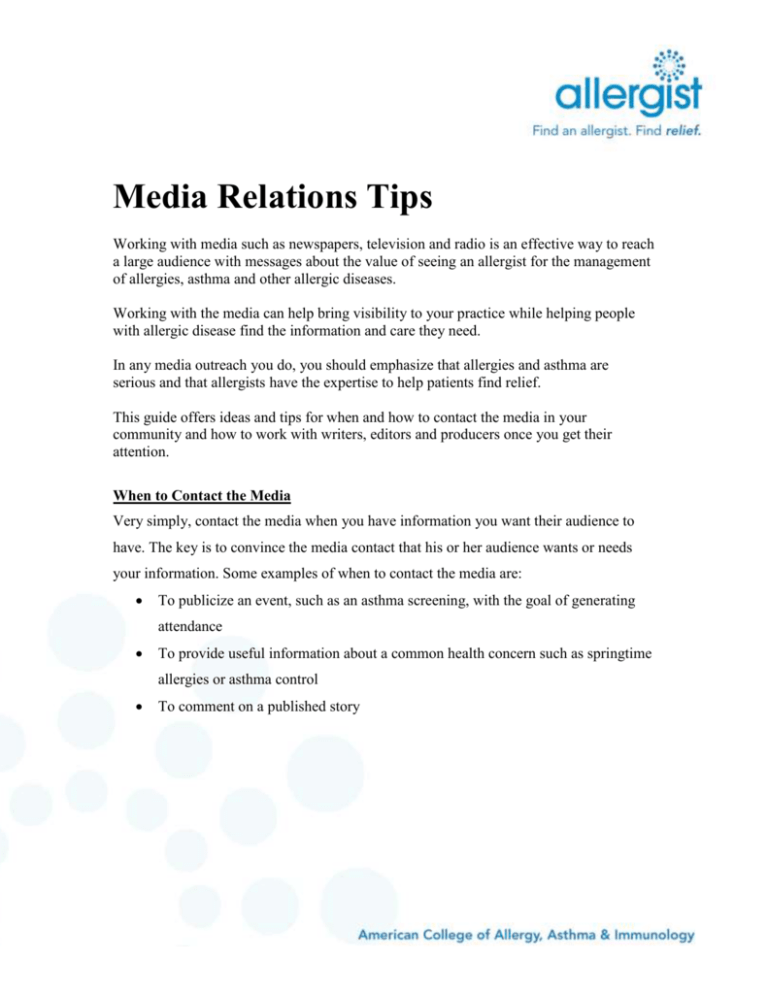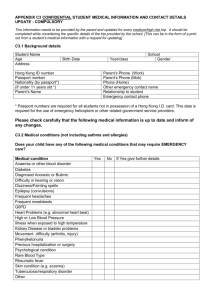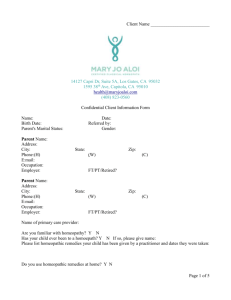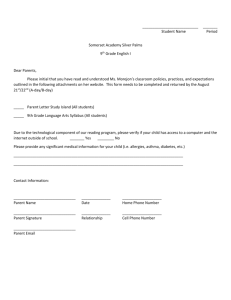Media Relations Tips
advertisement

Media Relations Tips Working with media such as newspapers, television and radio is an effective way to reach a large audience with messages about the value of seeing an allergist for the management of allergies, asthma and other allergic diseases. Working with the media can help bring visibility to your practice while helping people with allergic disease find the information and care they need. In any media outreach you do, you should emphasize that allergies and asthma are serious and that allergists have the expertise to help patients find relief. This guide offers ideas and tips for when and how to contact the media in your community and how to work with writers, editors and producers once you get their attention. When to Contact the Media Very simply, contact the media when you have information you want their audience to have. The key is to convince the media contact that his or her audience wants or needs your information. Some examples of when to contact the media are: To publicize an event, such as an asthma screening, with the goal of generating attendance To provide useful information about a common health concern such as springtime allergies or asthma control To comment on a published story How to Contact the Media Often the simplest and most effective way to contact the media is to pick up the phone and call. It’s important to be prepared with a brief, compelling “pitch.” For example: “We are conducting free asthma screenings at the mall next month, and I was hoping you would help us tell the public about it. Many people in our community have asthma and don’t know it. Our event is designed to help those at risk get the help they need and keep their asthma under control.” “May is National Allergy and Asthma Awareness Month, and this spring is shaping up to be one of the worst allergy seasons in several years. I would be happy to talk to you about the latest allergy and asthma treatments.” “We saw your recent article on a sublingual immunotherapy. As you noted, this treatment is not approved by the FDA just yet, but we can provide you with additional information on immunotherapy and how existing treatments help millions of patients. I have a patient who has struggled with allergies for years who also can tell you about how she finally got her condition under control with the help of allergy shots.” After making the call, you may need to follow up with additional information. There are several types of materials the media are accustomed to receiving: News release. As the name suggests, a news release should announce news – a new treatment for allergies, an event, the opening of a facility or the launch of a program or campaign. News alert/media advisory/calendar alert. Like a news release, an alert or advisory provides news, usually in a shorter format than a news release. It is typically used to announce an event or a press conference and is designed to provide the facts – the who, what, when, where, and why – in a quick and succinct manner, often in bullet points. Pitch letter. These letters – often emails – are used to interest a reporter in a feature story, a trend article or some type of story that is less time sensitive than news announced through a news release or alert. Often these materials are used in some combination, or may be used with a fact sheet or editorial background document that provides additional information on the topic. Whom to Contact It’s also important to know whom to contact. For example: Events – calendar editors, public service directors, community news director Feature stories – health writers and producers, feature editors Comment on issue or story in the news – editorial page editor, letters to the editor Depending on the type of news you have, develop an appropriate list of media to contact. A media list is simply a list of reporters, editors and broadcast producers that you hope to interest in your story. To develop your own list of media, you can use a local telephone directory, the Internet or library reference books to identify: Daily newspapers Weekly community newspapers Television stations, including specific news, talk and community affairs programs Radio stations, also including specific news, talk and community affairs programs Call each of the media outlets on your list to obtain the names of the calendar editor, news editor, medical or health reporter, feature reporter, public service director and any others who might be interested in stories about asthma and allergies. You also can reach out to the online editors of local newspapers, and television and radio stations. Their Web sites often include a calendar of community events. Additional publications to consider for your media list are the employee and member newsletters published by area businesses, industries, allied health professionals, schools, churches and community groups. Call active organizations in your area to determine appropriate newsletters and contacts. Your local Chamber of Commerce may be able to provide useful information about community groups. Building Relationships with Media As you work with the media, you can build relationships with them so that you can generate coverage in the future. Here are some things you can do to establish a good working relationship: Provide information in a timely fashion. Read their articles and watch or listen to their broadcast segments so you can talk with them about their work. Send an email, write a letter or submit a blog entry about a story. If they feature your story, send a thank-you note. How to Publicize an Event If there’s an allergy or asthma event planned for your community, media coverage will help you generate attendance, as well as publicize the event to a wider audience. Here’s a how-to guide for publicizing an event. Background Work Identify individuals (organizers, participants) with compelling stories willing to be spokespeople. Determine availability for interviews (e.g., could they go to the local NBC affiliate’s studio at 5:30 a.m. on a weekday for an interview?). Prepare and disseminate talking points to spokespersons. Build media list, including calendar editors, features reporter, health reporters. Create Media Materials News alert with event details – try to keep this to one page News release profiling compelling participant Allergy or asthma fact sheet Media Outreach Timeline 3 – 4 months before event Distribute calendar alert to local monthly magazines. 6 – 8 weeks before event Distribute calendar alert to daily and weekly newspaper calendar editors. Send news release to daily and weekly newspaper features reporters and follow up. 4 weeks before event Pitch television station health/features reporter/segment producers. 2 weeks before event Contact television morning program producers to propose advance interviews to promote event attendance. Contact radio program producers to offer interviews. Week of event Contact television station planning/assignment editors to encourage day-of coverage. How to Write a Letter to the Editor The letters to the editor page is one of the most widely read sections of the newspaper. The published letters allow the public to comment on a newspaper’s coverage of particular issues and can influence future coverage. The more letters the newspaper receives on a particular subject, the more likely they will run at least one letter on the topic. Find out if there is a word count guideline. Here are some tips for writing an effective letter to the editor: Respond to a recent article, editorial or column. By connecting your opinion to a current topic, you can greatly increase your chances of being published. Timing counts. Your letter should be in response to a recent story. Draft and send your letter as soon as possible, if possible within a day or two. E-mail has compressed the time between the publication of an article and letters responding to it. Be clear and concise. Keep your letters brief and to your point. Newspaper editors often edit for length, so try to keep your letter to less than 200 words. The shorter it is, the more likely it will be printed. Use short punchy sentences. Short sentences are easier for the reader to comprehend and follow your thinking. Have a clear and strong point of view. Letters that take a vigorous position are more interesting and more likely to be published. Don’t rant or whine. Take a strong position, but don’t use letters to the editor as an opportunity to vent, especially at a reporter. Other Tips: Send letters to weekly community newspapers, too. Smaller papers receive fewer letters, so they may be more likely to publish your letter. Be sure to include your contact information. Many newspapers will print a letter to the editor only after calling the author to verify his or her identity and address. Newspapers will not give out that information and will usually print only your name and city should your letter be published. Make references to the newspaper. While some papers print general commentary, many will print only letters that refer to a specific article. Here are some examples of easy ways to refer to articles in your opening sentence: Thank you for highlighting allergies in your May 18 article, “Survivor Marches On.” I was disappointed to see food allergies left out of Susan Miller’s recent article on children’s health dangers (“Kids’ health dangers” May 4). How to Place an Op-Ed Op-Ed is shorthand for “opposite the editorial page” and is where a newspaper’s columnists and guest columnists appear. Op-Eds are most appropriate as commentary on an issue in the news. Find a “news hook.” Editorial desk editors can receive hundreds of op-eds a week on a variety of issues. The challenge is finding the right time to submit your op-ed. Knowing what your target newspaper has covered can give you insights into the kinds of issues on which they report. Try to write about an issue that is important to you and your community but hasn’t been covered extensively by your targeted newspaper. Also, if you can pin your story to a new development such as new data or an upcoming event, that can improve your chances of being printed. Know the word limit. Most newspapers post their op-ed word count on their Web sites, but you can find it in the newspaper as well. You should determine the word count before writing your piece. A minimum of 750 to 800 words is typical, but check to make sure. Draw the reader in, but get to the point. Your first paragraph should draw the reader in by using a dramatic vignette or a well-stated argument. If you choose to open with an anecdote or other device, make sure you get to the point quickly. “Humanize” your article. Sharing a personal story is a powerful approach you can incorporate in your op-ed, and it can help illustrate a complex issue. Make a specific recommendation. This is an opinion piece. Give your perspective on how a situation can be improved. Avoid jargon. Simple language ensures that all readers can understand your point. Write simply and clearly. End with a bang. Your final paragraph is as important as your opening paragraph. Be sure to summarize your argument in one strong final paragraph. Follow up. Most op-ed editors, if interested, will respond within a week to verify authorship of the op-ed. If you haven’t heard anything in that time frame or if your piece is particularly time sensitive, you can make one follow-up phone call to ask about its status. Also, if you haven’t heard back from your first target newspaper, you may want to consider submitting your op-ed to another. You should avoid submitting the same op-ed to two different outlets at the same time. This is a sure way to jeopardize your relationship with the media. Tips for Successful Media Interviews Whether you are participating in a live broadcast interview or in a newspaper interview in person or by telephone, here are some tips for making it a success. Before the Interview Confirm the interview time, date and place by telephone or e-mail. Provide the interviewer with background information. Ask if the interviewer wants to talk to any additional spokespersons or patients. Do your homework. Prepare for the interview by reviewing and knowing the latest facts and figures about your topic. Arrive 15 minutes early to familiarize yourself with the setting and then relax. During the Interview Know the key points you want to communicate and state them early during the interview. Don’t wait to be asked. Repeat the key points at least twice during the interview so the reporter knows you think this information is important. For example, points you might want to stress in an interview on asthma are: o The incidence of asthma is increasing. o People don’t have to make lifestyle compromises if they have asthma, and they need to make sure their condition is under control. o Early and accurate diagnosis of asthma is important. o Allergists are medical specialists who treat asthma. Speak in short, concise sentences. Speak naturally. Use lay terms and avoid technical language and medical jargon. Use examples, stories and anecdotes when possible to illustrate or dramatize your message. Anticipate questions that are likely to be asked during the interview, and be prepared to use those questions as launching pads for your key points. Special Considerations for Television If possible, avoid sitting between two interviewers to prevent the disadvantage of constantly turning to answer questions. Maintain eye contact with the interviewer. Do not talk into the camera unless directed to do so. Lean slightly forward in your chair. This posture makes you appear interested. Sitting with legs crossed is the most comfortable and natural position for most people. Use natural hand gestures. Offer slides and graphs if appropriate. Use horizontal slides rather than vertical ones. Wear off-white, beige or pastels. Television lights can make a white shirt or blouse flare. The same can be true of bright colors such as reds and oranges. Avoid busy fabric patterns, such as herringbones, and shiny or satiny fabrics. They tend to reflect and “dance” under television lights. Wear calf-length socks with trousers to prevent bare skin showing between the sock top and trouser cuff. Women should avoid short skirts. Keep jewelry to a minimum. Avoid dangly earrings and flashy rings and watches.






![Pediatric Health Histroy.Initial child.d[...]](http://s3.studylib.net/store/data/006593866_1-7ecae25d724665d2a564380f86b41e96-300x300.png)
